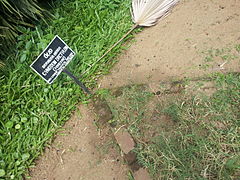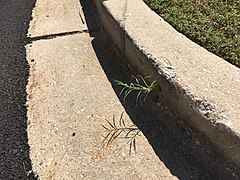
In botany and dendrology, a rhizome is a modified subterranean plant stem that sends out roots and shoots from its nodes. Rhizomes are also called creeping rootstalks or just rootstalks. Rhizomes develop from axillary buds and grow horizontally. The rhizome also retains the ability to allow new shoots to grow upwards.

Forage is a plant material eaten by grazing livestock. Historically, the term forage has meant only plants eaten by the animals directly as pasture, crop residue, or immature cereal crops, but it is also used more loosely to include similar plants cut for fodder and carried to the animals, especially as hay or silage.
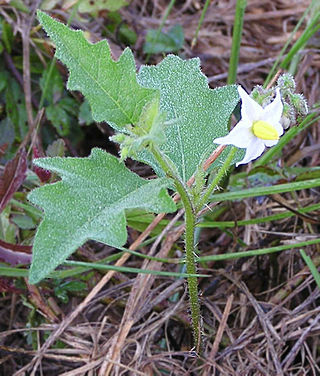
Solanum carolinense, the Carolina horsenettle, is not a true nettle, but a member of the Solanaceae, or nightshade family. It is a perennial herbaceous plant, native to the southeastern United States, though its range has expanded throughout much of temperate North America. The plant is an invasive in parts of Europe, Asia, and Australia. The stem and undersides of larger leaf veins are covered with prickles.
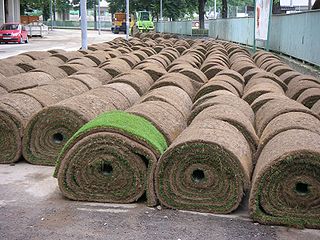
Sod is the upper layer of turf that is harvested for transplanting. Turf consists of a variable thickness of a soil medium that supports a community of turfgrasses.
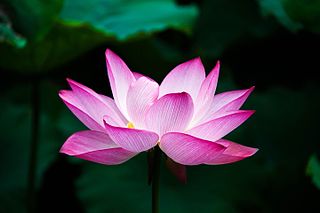
Nelumbo nucifera, also known as sacred lotus, Indian lotus, or simply lotus, is one of two extant species of aquatic plant in the family Nelumbonaceae. It is sometimes colloquially called a water lily, though this more often refers to members of the family Nymphaeaceae.

In biology, stolons, also known as runners, are horizontal connections between parts of an organism. They may be part of the organism, or of its skeleton. Typically, animal stolons are exoskeletons.

Paspalum is a genus of plants in the grass family.

Cynodon is a genus of plants in the grass family. It is native to warm temperate to tropical regions of the Old World, as well as being cultivated and naturalized in the New World and on many oceanic islands.

St. Augustine grass, also known as buffalo turf in Australia and buffalo grass in South Africa, is a species of grass in the family Poaceae. It is a warm-season lawn grass that is popular for cultivation in tropical and subtropical regions. It is a medium- to high-maintenance grass that forms a thick, carpetlike sod, crowding out most weeds and other grasses.
Heterodera sacchari, the sugarcane cyst nematode, mitotic parthenogenic sedentary endoparasitic nematode. This plant-parasitic nematode infects the roots of sugarcane, and the female nematode eventually becomes a thick-walled cyst filled with eggs. Aboveground symptoms are species specific and are similar to those caused by other Heterodera species. Symptoms include: stunted and chlorotic plants, and reduced root growth. Seedlings may be killed in heavily infested soils.

Polygonatum odoratum, the angular Solomon's seal or scented Solomon's seal, is a species of flowering plant in the family Asparagaceae, native to Europe, the Caucasus, Siberia, the Russian Far East, China, Mongolia, Korea, Nepal and Japan. In the United Kingdom it is one of three native species of the genus, the others being P. multiflorum and P. verticillatum.
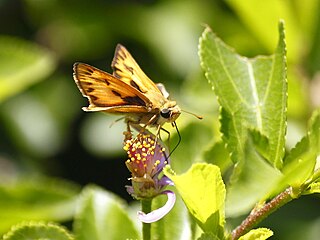
The fiery skipper is a species of butterfly in the family Hesperiidae. Reaching approximately 1 inch (2.5 cm) in length, male fiery skippers are orange or yellow while the females are dark brown. Small brown spots may be observed on both the hindwing and forewing of both sexes although to a varying degree. Females may be darker brown overall with pale checkered markings on the hindwing. Fiery skipper larvae, or caterpillars, are greenish pink-grey with a black head and constricted neck. These larvae are often considered pests and can feed on Bermudagrass, creeping bentgrass, and St. Augustine grass.

Panicum repens is a species of grass known by many common names, including torpedo grass, creeping panic, panic rampant, couch panicum, wainaku grass, quack grass, dog-tooth grass, and bullet grass. Its exact native range is obscure. Sources suggest that the grass is native to "Africa and/or Asia", "Europe or Australia", "Eurasia", "Australia", "Europe, Asia, and Africa", or other specific regions, including the Mediterranean, Israel, and Argentina. It is present in many places as an introduced species and often a noxious weed. It has been called "one of the world's worst weeds."

Smilax bona-nox, the saw greenbrier, is a species of plant in the family Smilacaceae. It is native to the Southern United States, and eastern Mexico.

Paspalum vaginatum is a species of grass known by many names, including seashore paspalum, biscuit grass, saltwater couch, silt grass, and swamp couch. It is native to the Americas, where it grows in tropical and subtropical regions. It is found throughout the other tropical areas of the world, where it is an introduced species and sometimes an invasive weed. It is also cultivated as a turfgrass in many places.

Bothriochloa pertusa is a species of grass. It is widely used as a fodder and a graze for livestock.
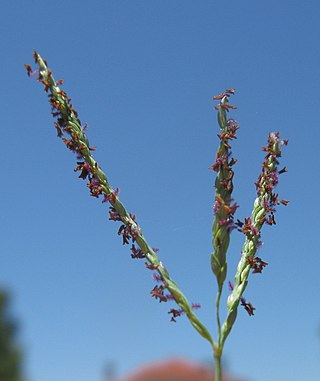
Digitaria didactyla is a species of grass known by the common names blue couch, Queensland blue couch, blue serangoon grass, green serangoon grass, blue stargrass, and petit gazon. It is native to Mauritius, Réunion, parts of mainland Africa, and Madagascar. It has been introduced widely outside its native range, mainly for use as a pasture and turf grass. It has naturalized in some regions.
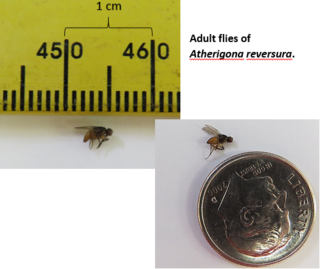
Atherigona reversura, the bermudagrass stem maggot, is a muscid shoot-fly. The genus comprises more than 220 species, and some of them are very damaging pests in agriculture. The bermudagrass stem maggot takes its name from its host preference for bermudagrass and stargrass.

Zoysia japonica is a species of creeping, mat-forming, short perennial grass that grows by both rhizomes and stolons. It is native to the coastal grasslands of southeast Asia and Indonesia. The United States was first introduced to Z. japonica in 1895. It received its first import from the Chinese region of Manchuria. Today, Z. japonica has become one of the most widely used species of turfgrass in the United States and other countries worldwide such as in Brazil, serving as a close and cheaper alternative to bermudagrass.
Aceria cynodoniensis, the bermudagrass mite, is widely distributed, but only infests bermudagrass and its hybrids. It lives and develops under the leaf sheaths of its host plant. Infestations of the mite can cause destructive damage to bermudagrass turf and it is often regarded as a harmful pest.




